You can easily tailor vintage high-waisted jeans to get the perfect fit while keeping their unique charm. Start by measuring your waist and hips, noting any asymmetries. Use sharp scissors and a reliable sewing machine for clean cuts and sturdy seams. Adjust the waistband by marking and cutting in a triangular shape for a flattering look. To slim the legs, take in the inseams gently to maintain that vintage aesthetic. Consider adding personal touches like patches or embroidery for a customized flair. With a few simple steps, you can transform your jeans into a one-of-a-kind piece that truly reflects your style. Explore further to uncover even more tips!
Understanding Vintage Jeans Fit
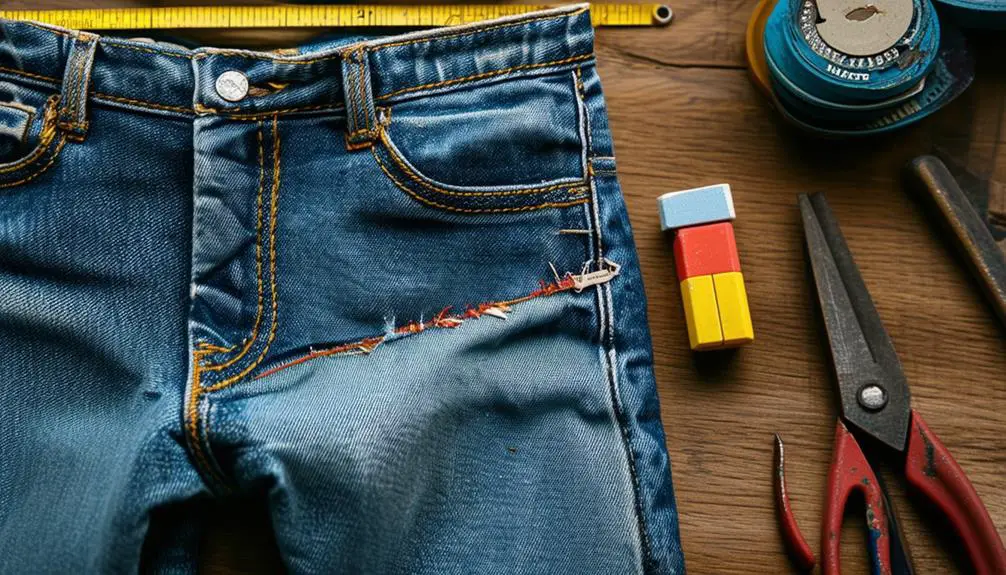
When it comes to vintage high-waisted jeans, understanding the fit is vital for achieving that perfect look. Unlike modern styles, vintage jeans often come with inconsistent sizing, so before making any alterations, measure your waist and hips accurately. This will help you navigate the unique sizing quirks that vintage denim presents.
Additionally, knowing how to identify vintage clothing characteristics can guide you in determining the authenticity of your jeans, guaranteeing that you respect their historical context.
The rise of these jeans typically sits higher on the waist, which may require adjustments for a more contemporary silhouette. Keep in mind that vintage denim usually has less stretch than today's fabrics, so plan your alterations with comfort and mobility in mind. You'll want to confirm that any changes you make don't compromise the rigidity that gives the jeans their character.
Also, take note of the leg shapes, which can vary from tapered to wide-legged. This diversity impacts the type of alterations you'll need to achieve your desired look.
Essential Tools for Alterations
To successfully alter vintage high-waisted jeans, you'll need a few essential tools that streamline the process and guarantee a polished outcome. First, a reliable sewing machine is vital for precision stitching, making certain that your alterations are neat and durable.
Pair it with a sharp pair of scissors to cut fabric cleanly when making adjustments. You'll also want a measuring tape to check the fit accurately before diving into any alterations. This tool helps you avoid mistakes and makes sure that your jeans fit just right.
Don't forget to grab some pins to secure the fabric in place while you work; they're essential for holding everything steady before you start sewing. Chalk or fabric markers will be your best friends for marking alteration lines clearly on the denim, making it easier to follow your planned adjustments.
Additionally, sourcing jean buttons and elastic from craft stores can help you adjust the waistband and enhance the overall fit. For added durability, consider using embroidery thread, which stands up well to wear and washing.
Measuring for Accurate Adjustments
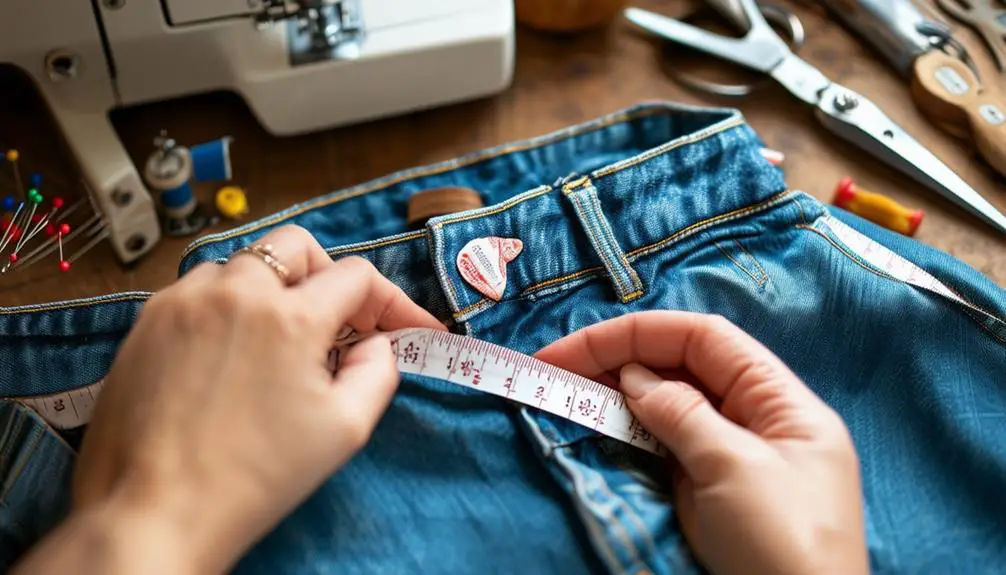
With your tools ready, it's time to focus on measuring for precise adjustments. Start by grabbing your measuring tape and wrapping it around your current waistband. This gives you a solid baseline for adjustments. Note this measurement down, then decide how much you'd like to reduce the waist size, keeping in mind any potential shrinkage after washing.
Next, take chalk or a fabric marker and clearly mark the points on the fabric where the alterations will happen. Visibility is essential during the sewing process, so don't skimp on this step!
If you're aiming for symmetrical adjustments, measure and mark both sides of the waistband to guarantee a balanced fit afterward.
Visualize the shape of your alteration; for instance, if you're taking in the waist, think about creating a triangle shape. Mark the top and bottom points carefully before you cut.
Techniques for Waistband Alterations
Altering the waistband of your vintage high-waisted jeans can transform them into a perfectly fitting masterpiece. Vintage garments, such as those from notable brands like Betty Barclay, often feature unique construction techniques that require careful handling.
Here are some techniques to help you achieve that flawless fit:
- Measure and Mark: Carefully measure and mark the desired waist size reduction. This guarantees a symmetrical fit, which is essential for a polished look.
- Create a Triangular Shape: To take in the waistband, mark the top points and extend downward to your desired length. Cut along this line to create a triangular shape, making it easier to sew the new waist size.
- Reinforce for Durability: After sewing, backstitch to reinforce the waistband. This is especially important for vintage fabric, which can be more delicate and prone to fraying.
If the waistband needs more flexibility, consider incorporating elastic or jean buttons to maintain the original aesthetic while allowing for some adjustability.
Slimming and Length Adjustments
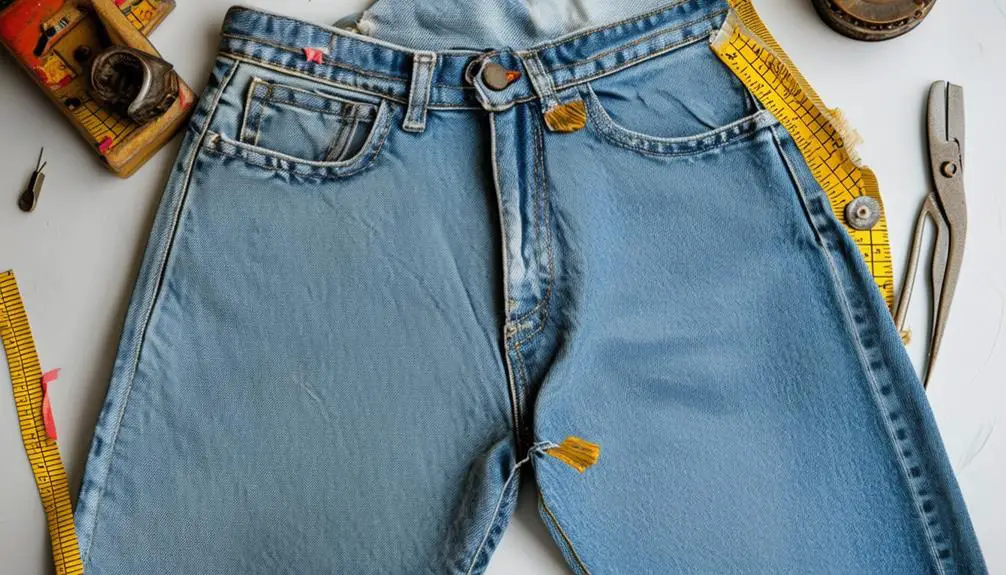
When you're looking to achieve a tailored look for your vintage high-waisted jeans, slimming and length adjustments play an essential role.
To slim your jeans, focus on taking in the inseams. This method keeps the exterior fading intact, preserving the denim's original character. Just a small adjustment of about 0.5 inches can dramatically improve comfort and fit, so be sure to measure accurately at the widest points of your thighs for a balanced silhouette.
For length adjustments, consider shortening your jeans while maintaining the original hem. This technique avoids mismatched fading, which can detract from their vintage appeal. You can place the seam just above the hem for a discreet finish that looks seamless.
If you have access to a chainstitch machine, use it for hemming; this creates a roping effect that enhances the jeans' visual integrity.
Cuffing and Hemming Methods
As you immerse yourself in styling your vintage high-waisted jeans, mastering cuffing and hemming methods can elevate your look considerably. Consider these three techniques to enhance your denim game:
- Cuffing: Fold the fabric at the hem to create a trendy tapered silhouette, guaranteeing your cuffs are even for a polished appearance.
- Raw Hem: Leave the fabric edge unhemmed for a casual vibe. Alternatively, for a finished hem, fold the fabric under, pin it, and sew along the hemline for durability.
- Chainstitching: Use a chainstitch machine to achieve a roping effect that adds aesthetic flair to your jeans.
When hemming, be sure to carefully cut along marked lines to avoid mismatched fading. This way, you can preserve the original hem fading and guarantee your alterations blend seamlessly with the vintage style.
After sewing, press the hem with an iron for a neat finish and to maintain the shape of your cuffed or hemmed jeans.
Adding Personal Touches
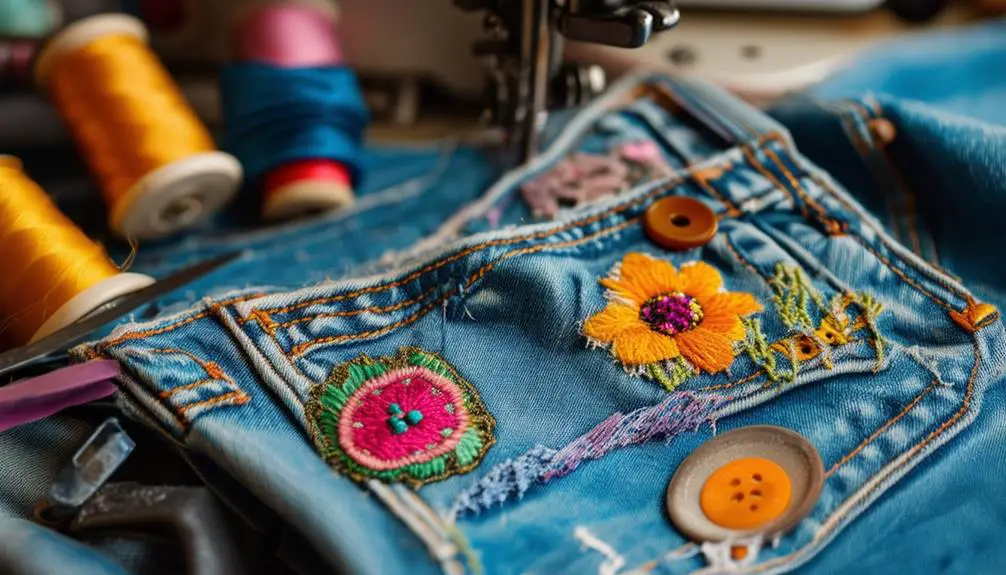
How can you make your vintage high-waisted jeans truly yours? Start by adding embellishments that reflect your personal style. Consider attaching patches that not only enhance the vintage look but also cover any imperfections or wear. This adds a unique character to your jeans, making them truly one-of-a-kind.
Next, think about incorporating embroidery. Whether you choose floral patterns or geometric designs, this technique can inject a creative flair into your jeans. Just imagine the transformation as your jeans become a canvas for your artistic expression!
If you're feeling adventurous, experiment with fabric dye. Changing the color can give your jeans a fresh, custom appearance that stands out in a crowd.
For a modern twist, try some distressing techniques like fraying the hem or creating small rips; this keeps the history of your jeans alive while updating their look.
Care Tips for Altered Jeans
Taking care of your altered vintage high-waisted jeans is essential to maintaining their unique fit and style. By following these care tips, you'll guarantee they stay in top shape for years to come:
- Wash in Cold Water: Always wash your altered jeans in cold water. This helps maintain their shape and prevents further shrinkage after adjustments.
- Avoid High Heat: When drying, skip the high heat settings. Excessive heat can lead to additional shrinkage and distort the fit you worked hard to achieve.
- Iron on Low: If you need to remove wrinkles, iron your jeans on a low setting. This safeguards the fabric and the integrity of your alterations.
Additionally, store your jeans folded rather than hanging to preserve their shape, especially around the waistband and hems.
Regularly inspect the seams and areas where you made alterations for signs of wear and tear. These points can experience stress over time and might require repairs.
Common Tailoring Challenges
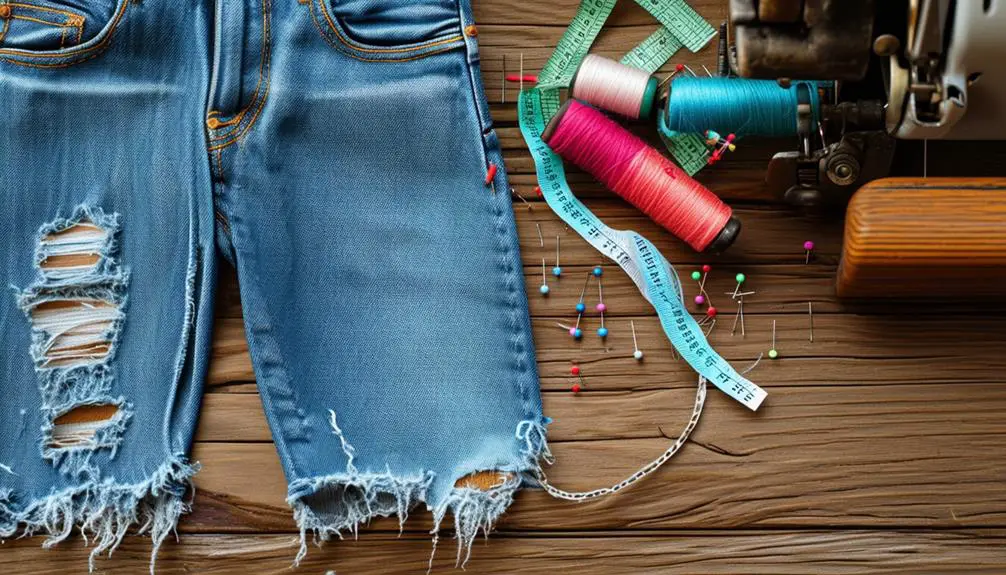
Steering through the world of tailoring vintage high-waisted jeans presents a unique set of challenges that can test even the most seasoned DIY enthusiast. One major hurdle is the inconsistent sizing found in vintage pieces, often requiring multiple alterations to achieve a perfect fit. The one-piece waistband design further complicates your efforts, as careful cutting or replacement is essential to maintain a natural look.
Additionally, the limited fabric inlays—approximately 0.5 inches on the inseam and 0.75 inches on the outseam—restrict your adjustment options. You'll need to be strategic and precise in your alterations. Preserving the original fading and wear patterns is vital, too; those visible changes can disrupt the jeans' vintage appeal.
Balancing comfort and style is another challenge, as tighter fits can sometimes sacrifice one for the other. Here's a quick reference table summarizing these challenges:
| Challenge | Impact on Alterations | Solution |
|---|---|---|
| Inconsistent sizing | Difficult fit adjustments | Multiple alterations |
| One-piece waistband | Complicated alterations | Careful cutting |
| Limited fabric inlays | Restricted adjustments | Strategic planning |
| Maintaining fading | Risk of disrupting aesthetic | Careful stitching |
| Comfort vs. style | Possible compromise | Assess fit pre-alteration |
Benefits of DIY Tailoring
Steering through the challenges of tailoring vintage high-waisted jeans can be intimidating, but the rewards of DIY tailoring make it all worthwhile. Here are some benefits that'll inspire you to take on this creative project:
- Custom Fit: Tailoring allows you to achieve a fit that perfectly caters to your unique body shape, ensuring comfort and style that off-the-rack jeans often lack.
- Cost-effective Alternative: DIY tailoring saves you money, as you won't have to pay for professional services. With just a few basic materials, you can make personalized adjustments without breaking the bank.
- Boost Confidence: There's nothing quite like wearing well-fitted clothes. Successfully tailoring your jeans enhances your personal style and overall appearance, leaving you feeling more confident.
Additionally, engaging in DIY tailoring acts as a creative outlet, allowing you to express your fashion sense through personalized designs.
By upcycling vintage high-waisted jeans, you're also promoting sustainability, reducing waste, and extending the lifespan of your clothing.
Frequently Asked Questions
Can You Alter Jeans That Are Too High Waisted?
Absolutely, you can alter jeans that are too high-waisted. By carefully measuring and adjusting the waistband, you'll achieve a more comfortable fit while keeping the original style intact. Just remember to maintain the vintage aesthetic!
Can a Tailor Make Jeans Less High Waisted?
Yes, a tailor can make jeans less high-waisted. They'll carefully adjust the waistband, ensuring the denim matches seamlessly. Keep in mind, significant changes might alter the jeans' overall shape, so precision is key for a perfect fit.
How Do You Fix High Waisted Jeans That Are Too Big?
To fix high-waisted jeans that're too big, measure your waistband, mark desired reductions, and cut a triangular shape. Stitch securely, consider adding elastic for comfort, then wash in cold water to maintain fit.
How Do You Stretch the Waist of Vintage Jeans?
To stretch the waist of vintage jeans, try dampening the waistband with fabric spray, wearing them while they dry, or inserting elastic for extra comfort. Consider using a waistband stretcher for effective, gentle adjustments.
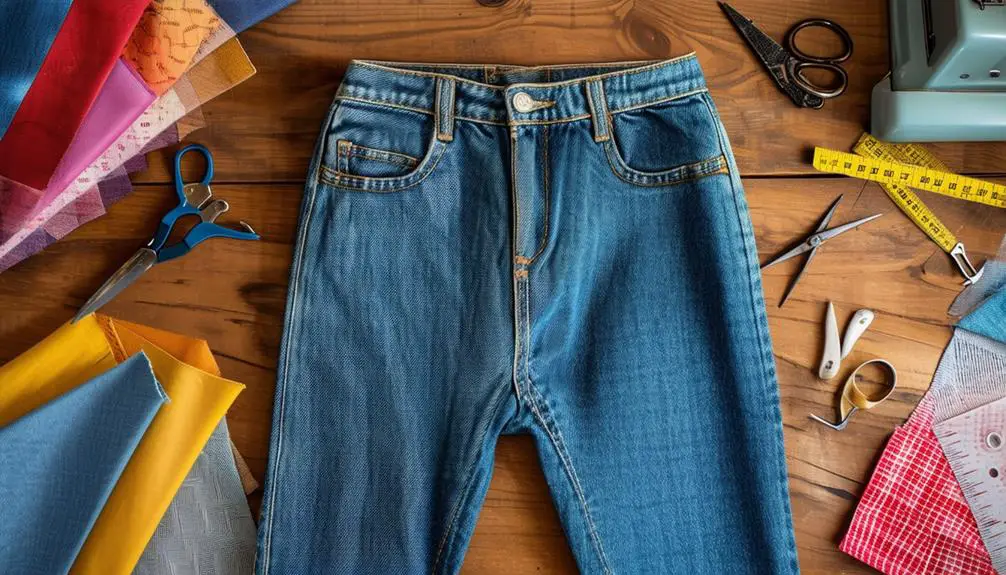

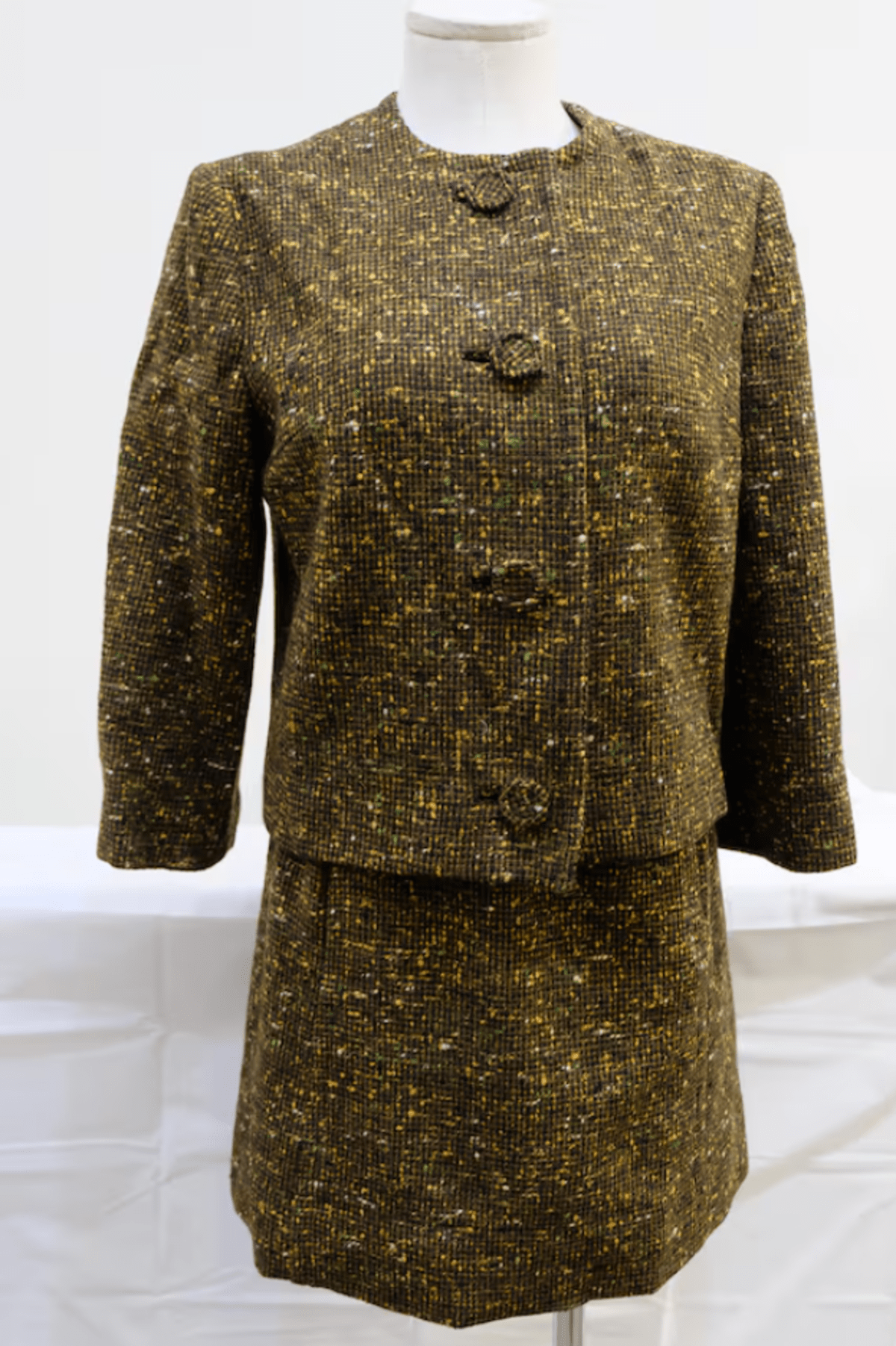
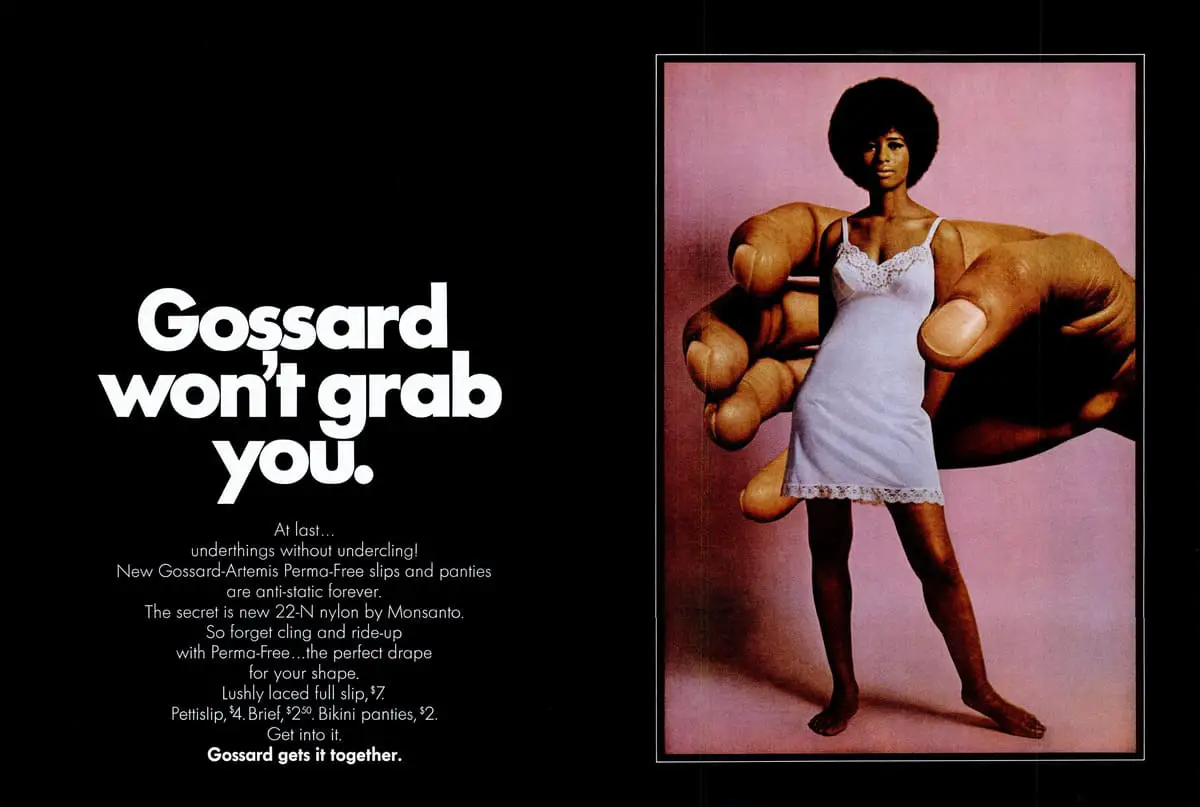

Your article helped me a lot, is there any more related content? Thanks!
Thanks for sharing. I read many of your blog posts, cool, your blog is very good. binance
Thanks for sharing. I read many of your blog posts, cool, your blog is very good.